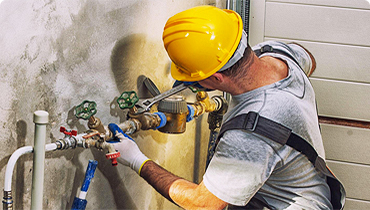Find Your water main –
Generally, water comes into a home from one of two ways: a residential well and private pump or a city water line. Rural residents that use well water (carried into the home via a pump) would not receive a water bill. Urban residents that use city water will pay for their water usage. The water main is the “main” pipeline that connects your home to the public water supply. The public water connection typically starts in the street, runs underground to the house and connects to the home’s exterior shut off valve, regulator and meter system.
Know how to turn on/off your water main
There is almost always a main valve near the street, and sometimes a secondary in or around the house, such as in the basement. The water main usually resembles a wheel or bar-type lever. If it’s a wheel, you should turn it slowly clockwise until it stops. If it’s a lever, you push right (or down) until it stops. Should your home spring some kind of leak, you will appreciate knowing right where to go so the water can be shutoff immediately.
You can test to make sure the water is off by trying to run water at a sink. If it does not run, then you did it right. It doesn’t hurt to practice this during a time when it is not an emergency.
Find the Individual cut-off valves
Check all your water-using appliances such as the washer, toilets and sinks to locate the small handle on them where you can stop their water supply. The washer handle is usually behind the item, near the wall. For the toilet, it’s usually down low, toward the back and close to the wall. For sinks, look underneath near the pipes or against the walls. Showers and bathtubs are harder but might have cut-off valves in an adjacent closet or in the basement at the supply line. These individual valves enable you to isolate one place that may need maintenance without having to shut off water to the entire house.
Monitor your water consumption
The water meter is a device connected to the water main that allows us to measure the volume of water going into a given property. It is suggested that reading the meter for a week (daily) to get a good sense of how much water you use on an average day is a good idea. That way if a significant increase begins to occur, you know that something is off. The number of gallons used can be monitored from the meter’s dial.
Test water quality
If you have well water, experts say it is good to test at least once per year. You can purchase a water-testing kit from many types of suppliers and the prices range between $50-$200. They reveal a number of different factors: nitrates, turbidity, heavy metals, bacteria, minerals, volatile organics and more. They come in consolidated kits that test for several common concerns at once. Most of the quality tests require you to capture some water and send it to a lab, which gives you results.
Warning signs your water line may need replacement
- Running Water – If you’re constantly hearing water running through the pipes when the water is not turned on, you probably have a problem. Likewise whistling, banging, or clanking sounds from the pipes can underscore that there is a problem.
- Low Water Pressure – You may notice low water pressure in your showers, kitchen faucet, etc. and this is often an indicator of a leak in your water line.
- Damp Spots – This may appear as a damp spot on drywall or a wet spot in the floors, ceiling or even your yard.
- Accumulated Water – This can show up as water in the street around your property line which could be a result of a ruptured pipe and bubble up into the street through cracks.
- High Water Bills – Check your water bill when it comes each month, because spikes in usage can indicate leaks or overconsumption or continually running water.

Leave a Reply
You must be <a href="https://backedupplumbing.com/adminlogin/?redirect_to=https%3A%2F%2Fbackedupplumbing.com%2F2022%2F05%2F01%2F5-ways-to-hire-painter-for-painting-in-your-home%2F">logged in</a> to post a comment.